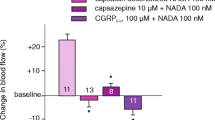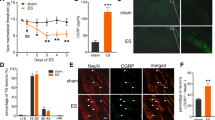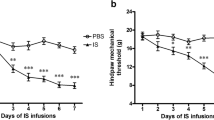Abstract
Extracellular ATP is suspected to contribute to migraine pain but regulatory mechanisms controlling pro-nociceptive purinergic mechanisms in the meninges remain unknown. We studied the peculiarities of metabolic and signaling pathways of ATP and its downstream metabolites in rat meninges and in cultured trigeminal cells exposed to the migraine mediator calcitonin gene-related peptide (CGRP). Under resting conditions, meningeal ATP and ADP remained at low nanomolar levels, whereas extracellular AMP and adenosine concentrations were one-two orders higher. CGRP increased ATP and ADP levels in meninges and trigeminal cultures and reduced adenosine concentration in trigeminal cells. Degradation rates for exogenous nucleotides remained similar in control and CGRP-treated meninges, indicating that CGRP triggers nucleotide release without affecting nucleotide-inactivating pathways. Lead nitrate-based enzyme histochemistry of whole mount meninges revealed the presence of high ATPase, ADPase, and AMPase activities, primarily localized in the medial meningeal artery. ATP and ADP induced large intracellular Ca2+ transients both in neurons and in glial cells whereas AMP and adenosine were ineffective. In trigeminal glia, ATP partially operated via P2X7 receptors. ATP, but not other nucleotides, activated nociceptive spikes in meningeal trigeminal nerve fibers providing a rationale for high degradation rate of pro-nociceptive ATP. Pro-nociceptive effect of ATP in meningeal nerves was reproduced by α,β-meATP operating via P2X3 receptors. Collectively, extracellular ATP, which level is controlled by CGRP, can persistently activate trigeminal nerves in meninges which considered as the origin site of migraine headache. These data are consistent with the purinergic hypothesis of migraine pain and suggest new targets against trigeminal pain.











Similar content being viewed by others
References
Moskowitz MA (1993) Neurogenic inflammation in the pathophysiology and treatment of migraine. Neurology 43:S16–S20
Olesen J, Burstein R, Ashina M, Tfelt-Hansen P (2009) Origin of pain in migraine: evidence for peripheral sensitisation. Lancet Neurol 8:679–690. doi:10.1016/S1474-4422(09)70090-0
Levy D (2012) Endogenous mechanisms underlying the activation and sensitization of meningeal nociceptors: the role of immuno-vascular interactions and cortical spreading depression. Curr Pain Headache Rep 16:270–277. doi:10.1007/s11916-012-0255-1
Zakharov A, Vitale C, Kilinc E et al (2015) Hunting for origins of migraine pain: cluster analysis of spontaneous and capsaicin-induced firing in meningeal trigeminal nerve fibers. Front Cell Neurosci. doi:10.3389/fncel.2015.00287
Burnstock G (1981) Pathophysiology of migraine: a new hypothesis. Lancet 317:1397–1399. doi:10.1016/S0140-6736(81)92572-1
Burnstock G, Ralevic V (2014) Purinergic signaling and blood vessels in health and disease. Pharmacol Rev 66:102–192. doi:10.1124/pr.113.008029
Fabbro A, Skorinkin A, Grandolfo M et al (2004) Quantal release of ATP from clusters of PC12 cells. J Physiol 560:505–517. doi:10.1113/jphysiol.2004.068924
Pangrsic T, Potokar M, Stenovec M et al (2007) Exocytotic release of ATP from cultured astrocytes. J Biol Chem 282:28749–28758. doi:10.1074/jbc.M700290200
Burnstock G, Krügel U, Abbracchio MP, Illes P (2011) Purinergic signalling: from normal behaviour to pathological brain function. Prog Neurobiol 95:229–274. doi:10.1016/j.pneurobio.2011.08.006
Karatas H, Erdener SE, Gursoy-Ozdemir Y et al (2013) Spreading depression triggers headache by activating neuronal Panx1 channels. Science 339:1092–1095. doi:10.1126/science.1231897
Yegutkin GG (2008) Nucleotide- and nucleoside-converting ectoenzymes: important modulators of purinergic signalling cascade. Biochim Biophys Acta 1783:673–694. doi:10.1016/j.bbamcr.2008.01.024
Zimmermann H, Zebisch M, Sträter N (2012) Cellular function and molecular structure of ecto-nucleotidases. Purinergic Signal 8:437–502. doi:10.1007/s11302-012-9309-4
Yegutkin GG (2014) Enzymes involved in metabolism of extracellular nucleotides and nucleosides: functional implications and measurement of activities. Crit Rev Biochem Mol Biol 49:473–497. doi:10.3109/10409238.2014.953627
Goadsby PJ, Hoskin KL, Storer RJ et al (2002) Adenosine A1 receptor agonists inhibit trigeminovascular nociceptive transmission. Brain 125:1392–1401
Zylka MJ, Sowa NA, Taylor-Blake B et al (2008) Prostatic acid phosphatase is an ectonucleotidase and suppresses pain by generating adenosine. Neuron 60:111–122. doi:10.1016/j.neuron.2008.08.024
Nair A, Simonetti M, Birsa N et al (2010) Familial hemiplegic migraine Ca(v)2.1 channel mutation R192Q enhances ATP-gated P2X3 receptor activity of mouse sensory ganglion neurons mediating trigeminal pain. Mol Pain 6:48. doi:10.1186/1744-8069-6-48
Deboer T, van Diepen HC, Ferrari MD et al (2013) Reduced sleep and low adenosinergic sensitivity in cacna1a R192Q mutant mice. Sleep 36:127–136. doi:10.5665/sleep.2316
Giniatullin R, Nistri A (2013) Desensitization properties of P2X3 receptors shaping pain signaling. Front Cell Neurosci 7:245. doi:10.3389/fncel.2013.00245
Chizh BA, Illes P (2001) P2X receptors and nociception. Pharmacol Rev 53:553–568
Wirkner K, Sperlagh B, Illes P (2007) P2X3 receptor involvement in pain states. Mol Neurobiol 36:165–183. doi:10.1007/s12035-007-0033-y
Fabbretti E, D’Arco M, Fabbro A et al (2006) Delayed upregulation of ATP P2X3 receptors of trigeminal sensory neurons by calcitonin gene-related peptide. J Neurosci 26:6163–6171. doi:10.1523/JNEUROSCI.0647-06.2006
Simonetti M, Giniatullin R, Fabbretti E (2008) Mechanisms mediating the enhanced gene transcription of P2X3 receptor by calcitonin gene-related peptide in trigeminal sensory neurons. J Biol Chem 283:18743–18752. doi:10.1074/jbc.M800296200
Giniatullin R, Nistri A, Fabbretti E (2008) Molecular mechanisms of sensitization of pain-transducing P2X3 receptors by the migraine mediators CGRP and NGF. Mol Neurobiol 37:83–90. doi:10.1007/s12035-008-8020-5
Zhang X, Chen Y, Wang C, Huang L-YM (2007) Neuronal somatic ATP release triggers neuron-satellite glial cell communication in dorsal root ganglia. Proc Natl Acad Sci U S A 104:9864–9869. doi:10.1073/pnas.0611048104
Helenius M, Jalkanen S, Yegutkin G (2012) Enzyme-coupled assays for simultaneous detection of nanomolar ATP, ADP, AMP, adenosine, inosine and pyrophosphate concentrations in extracellular fluids. Biochim Biophys Acta 1823:1967–1975. doi:10.1016/j.bbamcr.2012.08.001
Schueler M, Messlinger K, Dux M et al (2013) Extracranial projections of meningeal afferents and their impact on meningeal nociception and headache. Pain 154:1622–1631. doi:10.1016/j.pain.2013.04.040
Ceruti S, Fumagalli M, Villa G et al (2008) Purinoceptor-mediated calcium signaling in primary neuron-glia trigeminal cultures. Cell Calcium 43:576–590. doi:10.1016/j.ceca.2007.10.003
Mercier N, Kiviniemi TO, Saraste A et al (2012) Impaired ATP-induced coronary blood flow and diminished aortic NTPDase activity precede lesion formation in apolipoprotein E-deficient mice. Am J Pathol 180:419–428. doi:10.1016/j.ajpath.2011.10.002
Shatillo A, Koroleva K, Giniatullina R et al (2013) Cortical spreading depression induces oxidative stress in the trigeminal nociceptive system. Neuroscience 253:341–349. doi:10.1016/j.neuroscience.2013.09.002
Quiroga RQ, Nadasdy Z, Ben-Shaul Y (2004) Unsupervised spike detection and sorting with wavelets and superparamagnetic clustering. Neural Comput 16:1661–1687. doi:10.1162/089976604774201631
Simonetti M, Fabbro A, D’Arco M et al (2006) Comparison of P2X and TRPV1 receptors in ganglia or primary culture of trigeminal neurons and their modulation by NGF or serotonin. Mol Pain 2:11. doi:10.1186/1744-8069-2-11
Jindrichova M, Khafizov K, Skorinkin A et al (2011) Highly conserved tyrosine 37 stabilizes desensitized states and restricts calcium permeability of ATP-gated P2X3 receptor. J Neurochem 119:676–685. doi:10.1111/j.1471-4159.2011.07463.x
Olesen J, Diener H-C, Husstedt IW et al (2004) Calcitonin gene-related peptide receptor antagonist BIBN 4096 BS for the acute treatment of migraine. N Engl J Med 350:1104–1110. doi:10.1056/NEJMoa030505
Kawaguchi A, Sato M, Kimura M et al (2015) Expression and function of purinergic P2Y12 receptors in rat trigeminal ganglion neurons. Neurosci Res 98:17–27. doi:10.1016/j.neures.2015.04.008
Ceruti S, Villa G, Fumagalli M et al (2011) Calcitonin gene-related peptide-mediated enhancement of purinergic neuron/glia communication by the algogenic factor bradykinin in mouse trigeminal ganglia from wild-type and R192Q Cav2.1 knock-in mice: implications for basic mechanisms of migraine pain. J Neurosci 31:3638–3649. doi:10.1523/JNEUROSCI.6440-10.2011
Thalakoti S, Patil VV, Damodaram S et al (2007) Neuron-glia signaling in trigeminal ganglion: implications for migraine pathology. Headache 47:1008–1023. doi:10.1111/j.1526-4610.2007.00854.x, discussion 24–5
Messlinger K (2009) Migraine: where and how does the pain originate? Exp brain Res 196:179–193. doi:10.1007/s00221-009-1756-y
Abushik PA, Niittykoski M, Giniatullina R et al (2014) The role of NMDA and mGluR5 receptors in calcium mobilization and neurotoxicity of homocysteine in trigeminal and cortical neurons and glial cells. J Neurochem 129:264–274. doi:10.1111/jnc.12615
Oliveira JF, Riedel T, Leichsenring A et al (2011) Rodent cortical astroglia express in situ functional P2X7 receptors sensing pathologically high ATP concentrations. Cereb Cortex 21:806–820. doi:10.1093/cercor/bhq154
Magni G, Merli D, Verderio C et al (2015) P2Y2 receptor antagonists as anti-allodynic agents in acute and sub-chronic trigeminal sensitization: role of satellite glial cells. Glia 63:1256–1269. doi:10.1002/glia.22819
Rassendren F, Buell GN, Virginio C et al (1997) The permeabilizing ATP receptor, P2X7. Cloning and expression of a human cDNA. J Biol Chem 272:5482–5486
Magni G, Ceruti S (2013) P2Y purinergic receptors: new targets for analgesic and antimigraine drugs. Biochem Pharmacol 85:466–477. doi:10.1016/j.bcp.2012.10.027
Aspelund A, Antila S, Proulx ST et al (2015) A dural lymphatic vascular system that drains brain interstitial fluid and macromolecules. J Exp Med 212:991–999. doi:10.1084/jem.20142290
Louveau A, Smirnov I, Keyes TJ et al (2015) Structural and functional features of central nervous system lymphatic vessels. Nature 523:337–341. doi:10.1038/nature14432
Staikopoulos V, Sessle BJ, Furness JB, Jennings EA (2007) Localization of P2X2 and P2X3 receptors in rat trigeminal ganglion neurons. Neuroscience 144:208–216. doi:10.1016/j.neuroscience.2006.09.035
Di Angelantonio S, Giniatullin R, Costa V et al (2003) Modulation of neuronal nicotinic receptor function by the neuropeptides CGRP and substance P on autonomic nerve cells. Br J Pharmacol 139:1061–1073. doi:10.1038/sj.bjp.0705337
Hautaniemi T, Petrenko N, Skorinkin A, Giniatullin R (2012) The inhibitory action of the antimigraine nonsteroidal anti-inflammatory drug naproxen on P2X3 receptor-mediated responses in rat trigeminal neurons. Neuroscience 209:32–38. doi:10.1016/j.neuroscience.2012.02.023
Ralevic V, Burnstock G (1998) Receptors for purines and pyrimidines. Pharmacol Rev 50:413–492
Lalo U, Palygin O, Rasooli-Nejad S et al (2014) Exocytosis of ATP from astrocytes modulates phasic and tonic inhibition in the neocortex. PLoS Biol 12, e1001747. doi:10.1371/journal.pbio.1001747
Gurden MF, Coates J, Ellis F et al (1993) Functional characterization of three adenosine receptor types. Br J Pharmacol 109:693–698
Nascimento FP, Macedo-Júnior SJ, Pamplona FA et al (2015) Adenosine A1 receptor-dependent antinociception induced by inosine in mice: pharmacological, genetic and biochemical aspects. Mol Neurobiol 51:1368–1378. doi:10.1007/s12035-014-8815-5
Goadsby PJ, Lipton RB, Ferrari MD (2002) Migraine—current understanding and treatment. N Engl J Med 346:257–270. doi:10.1056/NEJMra010917
Burnstock G (1989) The role of adenosine triphosphate in migraine. Biomed Pharmacother 43:727–736
Messlinger K, Fischer MJM, Lennerz JK (2011) Neuropeptide effects in the trigeminal system: pathophysiology and clinical relevance in migraine. Keio J Med 60:82–89
Rosa AC, Fantozzi R (2013) The role of histamine in neurogenic inflammation. Br J Pharmacol 170:38–45. doi:10.1111/bph.12266
Brain SD, Hughes SR, Cambridge H, O’Driscoll G (1993) The contribution of calcitonin gene-related peptide (CGRP) to neurogenic vasodilator responses. Agents Actions 38 Spec No:C19–21.
Levy D, Burstein R, Strassman AM (2005) Calcitonin gene-related peptide does not excite or sensitize meningeal nociceptors: implications for the pathophysiology of migraine. Ann Neurol 58:698–705. doi:10.1002/ana.20619
Sokolova E, Skorinkin A, Fabbretti E et al (2004) Agonist-dependence of recovery from desensitization of P2X(3) receptors provides a novel and sensitive approach for their rapid up or downregulation. Br J Pharmacol 141:1048–1058. doi:10.1038/sj.bjp.0705701
Acknowledgments
This project was supported by the Finnish Academy (grant 277442).
Author information
Authors and Affiliations
Corresponding author
Ethics declarations
The animal treating procedures were approved by the Committee for the Welfare of Laboratory Animals of the University of Eastern Finland and the Provincial Government of Kuopio and experiments conducted in the accordance with the guidelines of the European Community Council (Directives 86/609/EEC). All efforts were made to minimize the number of animals used and their suffering.
Conflict of interest
The authors state that there is no conflict of interest and that the research was conducted in the absence of any commercial or financial relationships.
Additional information
Gennady G. Yegutkin and Cindy Guerrero-Toro contributed equally to this work.
Rights and permissions
About this article
Cite this article
Yegutkin, G.G., Guerrero-Toro, C., Kilinc, E. et al. Nucleotide homeostasis and purinergic nociceptive signaling in rat meninges in migraine-like conditions. Purinergic Signalling 12, 561–574 (2016). https://doi.org/10.1007/s11302-016-9521-8
Received:
Accepted:
Published:
Issue Date:
DOI: https://doi.org/10.1007/s11302-016-9521-8




